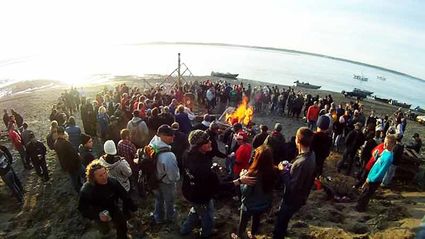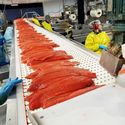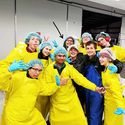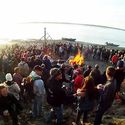Seasonal work in an Alaskan fishery: "the key to making money is overtime!"
October 3, 2018

Megan Singh, a 2012 CHS graduate, spent part of last summer working as a processor at Leader Creek Fisheries in Naknek, Alaska. During the salmon run processors work 16 hour days, seven days a week at the processing and packaging plant. It was not uncommon to work 100+ hours per week during the salmon run. Since her return to Chinook she works for the Chamber of Commerce.
Reporter's note: For a couple of years my wife and I lived in the Seattle area. Reading the local papers I was always curious about the ads for temporary help on fishing boats, on canning ships and in fish processing plants both locally and in far flung areas of the world. I'll have to say my interest in working on a fishing boat cooled a bit after seeing the movie "Perfect Storm" and watching the "Deadliest Catch" TV series. However, my curiosity about the fishing industry in Alaska still persists.
When I interviewed Megan Singh a few weeks ago for a short story about her joining the Chinook Chamber's office staff, I was surprised to learn she worked last summer at a fishery in Alaska. Recently I sat down with Megan to learn something about temporary work in a facility that processes, packages and ships Alaskan sockeye salmon all over the world. Here's some of what she shared.
Hundreds drawn to Alaska with prospects of big bucks at a summer job
The phrase in quotation marks in the title for this story is direct from the website of Leader Creek Fisheries, an Alaskan based company that catches and processes sockeye salmon during the annual salmon run in southwest Alaska on Bristol Bay. Leader Creek has to recruit and hire about 400 temporary employees to process the annual salmon run. Recruiting temporary summer employees for many fisheries in Alaska is a major human resources challenge.
Megan Singh, who graduated from Chinook High in 2012, was one of those 400 processors who worked at Leader Creek Fisheries last summer. She said, "I was living in Texas thinking about a change in scenery. Three of my friends told me they had applied for a job to work in Alaska." Megan said she was not really excited about the prospect of working in a fishery but applied anyway. Turns out the company didn't hire her friends but hired Megan. "After I heard I had been hired," she added, "I got really excited about going to Alaska."
The recruiting process for Megan began online. She completed an online application that she described as "generic." One challenging part of the application was to answer the question, "Why do you want this job in Alaska" using only 140 letters. She wrote, "I hope to move to Alaska and I think this opportunity would be a good way to get my foot in the door."
To attract workers to Naknek, where the processing plant is located, Leader Creek pays for the temporary employees to fly from Seattle to Anchorage, then fly from Anchorage to King Salmon where a bus picks up arriving workers for the half hour drive to Naknek. Workers have to get to Seattle on their own. Workers who fulfill their season contract also have their return flights to Seattle paid. Major living expenses like meals and housing are also covered as part of the benefits of the job.
Megan said, "Most of the people who worked prior summers were already there when I arrived. I arrived with a group of new "processors" and a few groups got there after me." After her orientation day "the plant got up to its full 24-hours per day operating speed. When the 24 hour run begins processors work 16 hour days, seven days per week for about a month. Megan began working the long shifts on June 24 and that schedule lasted until July 23. As the season came to a close and production slowed down, departments started operating at eight-hour periods. Her last few days she spent in another department before finishing at the plant on July 27.
Leader Creek Fisheries' website promises/warns prospective processors, "This is not a job for everyone but...overtime adds up quickly and when you are working with us you have very few expenses." It's not unusual for a processor to work 100+ hours per week during the major campaign. Because of her good work performance Megan was chosen to work the "super crew." The super crew stays on a few days past the regular campaign to help clean and prepare the plant for shutdown. She said the starting pay for first year processors was $10.25 per hour plus overtime.
Life at the fishery
Asked to describe the typical processer/worker at the plant, Megan said, "Most were 18-25 year-olds and many were college students. Most came from the west coast of the U.S. and Texas, but there were also workers from Mexico, the Philippines, Asia, Europe and other parts of the U.S. Only a minority actually were from Alaska." She learned later that Leader Creek set up booths at some college job fairs, mostly on the west coast, to recruit summer help.
A van picked up arriving and departing workers from the King Salmon airport, about a half hour' drive from Naknek where the processing plant and fishing fleet are located on the edge of Bristol Bay. Workers sleep in a two-story dormitory-type facility, six to a room. Megan explained, "With people coming and going on three shifts around the clock, the company tried to have pairs of people on
the same shift rooming together. That allowed for less crowded conditions." Overall she said, "Most people were respectful of others' space in the rooms." Bathrooms and showers were 'down the hall.'
The company provided safety gear and water repellant uniforms. Megan said, "We had to wear waterproof boots. You could bring boots from home or buy a pair of boots from the company. I took the option of renting a pair while I was there."
Because the nearest town was three miles away, the company provided snacks for breaks in addition to three meals every day. Megan said it didn't take long for groups that worked together also to eat and socialize in the same groupings. She explained, "All of us were working very long hours doing physically taxing jobs. The shared experience seemed to draw us together because we were all dealing with a common set of issues and challenges."
Workers were assigned to teams and their shifts would overlap a bit when a new crew came on. Supervisors were called "leads" and were often not much older than the workers they supervised. The leads were experienced in the jobs they supervised and Megan described them as "not just bosses, but also pals. They were very good at helping us learn our jobs."
Megan said it took a while to get used to the long shifts and no days off. "But," she said, "after a time you adapt to the conditions and things seem to go okay." The first few days she was in Alaska she had a cold. "The team of people in human resources," she explained, "really took care of us. It was not a problem to tell a supervisor that we weren't feeling well. They would send us to human resources for help." There was a clinic in King Salmon, an hour away, where serious emergency medical cases were taken.
Will she go back next year?
Asked if she will work next year, Megan said, "Word on the street is that the company sends you a Christmas card they if want you to reapply for next year. Even if I don't get a card, I'll reapply. I believe I have a good chance of being asked back. I was well-liked by my leads and got along with everyone. I wasn't bad at handling the filets either."

Part of the workers recruited by Leader Creek and Silver Bay fisheries, in Naknek, Alaska, socialize at a beach party before the 24 hour production began to process the salmon run from Bristol Bay. About 400 workers are recruited each year just to staff Leader Creek. Alaskan companies pay for travel, provide meals and housing and pay overtime to recruit enough summer help to handle the month long salmon run.
What she liked about the job, she said, was working with so many diverse people from so many interesting places. She explained, "We would have very intense conversations during and after work. I found it challenging to keep up with the discussions and defend my beliefs and ideas. It was intellectually stimulating." Megan told, "I was the first person from a small town that many of my co-workers had ever met. There were people with all sorts of ideas and beliefs that were new to me." She said, "My supervisors complimented my work ethic many times. I got an unexpected confidence boost I didn't realize I needed."
Reflecting on the most exciting thing she experienced in Alaska, she said, "It had to be the time a friend and I were stalked by a brown bear as we walked on the beach. We were walking between high cliffs we couldn't climb and the waters of the bay. We headed to the next fishery and finally got away from the bear that kept following us. It was both thrilling and scary at the same time."
Megan said it was difficult to leave her co-workers after such an intense, though short period of working together. "I have a couple of co-workers I visit with on social media every day, still," she said, "and several others that I hear from on a weekly basis." She said it was exciting to be a part of the group and become so close to people in such a short amount of time." It appears Megan Singh found a summer home and it seems fairly certain she'll be headed back to Alaska next year.






